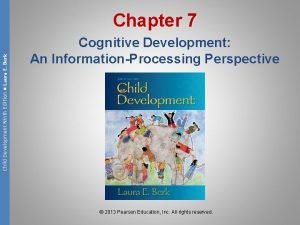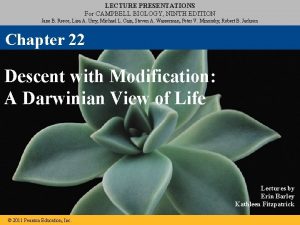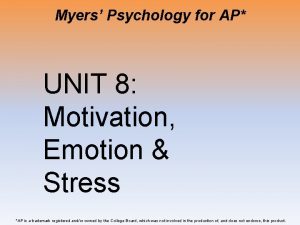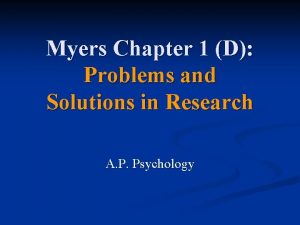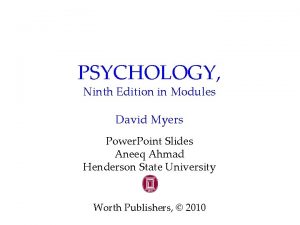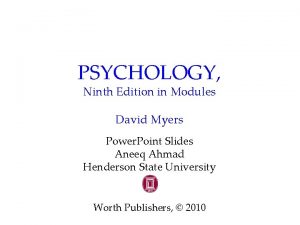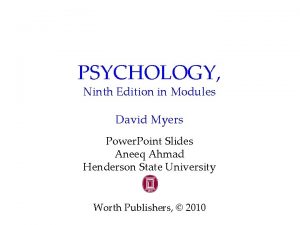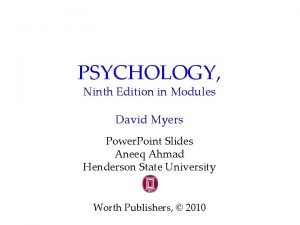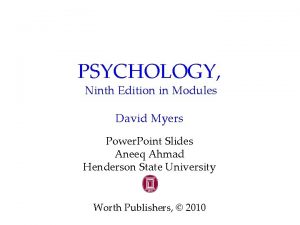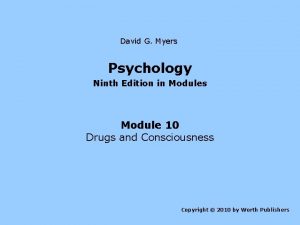Psychology Ninth Edition in Modules David Myers Power

























- Slides: 25

Psychology, Ninth Edition in Modules David Myers Power. Point Slides Aneeq Ahmad Henderson State University Worth Publishers, © 2010

Vision § The Stimulus Input: Light Energy § The Eye § Visual Information Processing § Color Vision

Transduction In sensation, the transformation of stimulus energy (sights, sounds, smells) into neural impulses.

Both Photos: Thomas Eisner The Stimulus Input: Light Energy Visible Spectrum

Physical Characteristics of Light 1. Wavelength (hue/color) 2. Intensity (brightness)

Wavelength (Hue) Hue (color) is the dimension of color determined by the wavelength of the light. Wavelength is the distance from the peak of one wave to the peak of the next.

Wavelength (Hue) Violet Indigo 400 nm Short wavelengths Blue Green Yellow Orange Red 700 nm Long wavelengths Different wavelengths of light result in different colors.

Intensity (Brightness) Intensity: Amount of energy in a wave determined by the amplitude. It is related to perceived brightness.

Intensity (Brightness) Blue color with varying levels of intensity. As intensity increases or decreases, blue color looks more “washed out” or “darkened. ”

The Eye

Parts of the eye 1. Cornea: Transparent tissue where light enters the eye. 2. Iris: Muscle that expands and contracts to change the size of the opening (pupil) for light. 3. Lens: Focuses the light rays on the retina. 4. Retina: Contains sensory receptors that process visual information and sends it to the brain.

The Lens: Transparent structure behind the pupil that changes shape to focus images on the retina. Accommodation: The process by which the eye’s lens changes shape to help focus near or far objects on the retina.

Retina: The lightsensitive inner surface of the eye, containing receptor rods and cones in addition to layers of other neurons (bipolar, ganglion cells) that process visual information.

Optic Nerve, Blind Spot & Fovea Optic nerve: Carries neural impulses from the eye to the brain. Blind Spot: Point where the optic nerve leaves the eye because there are no receptor cells located there. Fovea: Central point in the retina around which the eye’s cones cluster. http: //www. bergen. org

Test your Blind Spot Use your textbook. Close your left eye, and fixate your right eye on the black dot. Move the page towards your eye and away from your eye. At some point the car on the right will disappear due to a blind spot.

Photoreceptors E. R. Lewis, Y. Y. Zeevi, F. S Werblin, 1969

Bipolar & Ganglion Cells Bipolar cells receive messages from photoreceptors and transmit them to ganglion cells, which converge to form the optic nerve.

Visual Information Processing Optic nerves connect to the thalamus in the middle of the brain, and the thalamus connects to the visual cortex.

Feature Detection Ross Kinnaird/ Allsport/ Getty Images Nerve cells in the visual cortex respond to specific features, such as edges, angles, and movement.

Shape Detection Ishai, Ungerleider, Martin and Haxby/ NIMH Specific combinations of temporal lobe activity occur as people look at shoes, faces, chairs and houses.

Visual Information Processing of several aspects of the stimulus simultaneously is called parallel processing. The brain divides a visual scene into subdivisions such as color, depth, form, movement, etc.

From Sensation to Recognition

Color Vision Trichromatic theory: Young and von Helmholtz suggested that the eye must contain three receptors that are sensitive to red, blue and green colors. Standard stimulus Comparison stimulus Max Medium Low Blue Green Red

Color Blindness Genetic disorder in which people are blind to green or red colors. This supports the Trichromatic theory. Ishihara Test

Opponent Colors Gaze at the middle of the flag for about 30 Seconds. When it disappears, stare at the dot and report whether or not you see Britain's flag.
 Psychology ninth edition david g myers
Psychology ninth edition david g myers David myers psychology 9th edition
David myers psychology 9th edition Levels of analysis psychology
Levels of analysis psychology Psychology ninth edition in modules
Psychology ninth edition in modules Psychology eighth edition david g myers
Psychology eighth edition david g myers Psychology eighth edition david g myers
Psychology eighth edition david g myers Psychology tenth edition david g myers
Psychology tenth edition david g myers Social psychology ninth edition
Social psychology ninth edition Lysanx
Lysanx Motivational sources of prejudice
Motivational sources of prejudice Macroeconomics ninth edition
Macroeconomics ninth edition Anatomy and physiology edition 9
Anatomy and physiology edition 9 Biology ninth edition
Biology ninth edition Child development ninth edition
Child development ninth edition Child development ninth edition
Child development ninth edition Biology ninth edition
Biology ninth edition Campbell ninth edition
Campbell ninth edition Sociology in modules 4th edition
Sociology in modules 4th edition Ap psychology unit 8 motivation emotion and stress
Ap psychology unit 8 motivation emotion and stress Myers psychology for ap
Myers psychology for ap Myers' psychology for ap solutions
Myers' psychology for ap solutions Psychology in everyday life myers
Psychology in everyday life myers Myers' psychology for ap
Myers' psychology for ap Power triangle
Power triangle Ninth commandment catholic
Ninth commandment catholic The sixth and ninth commandments
The sixth and ninth commandments













